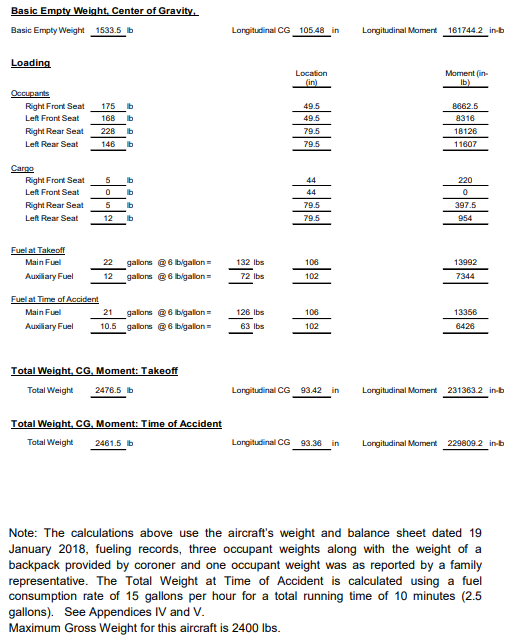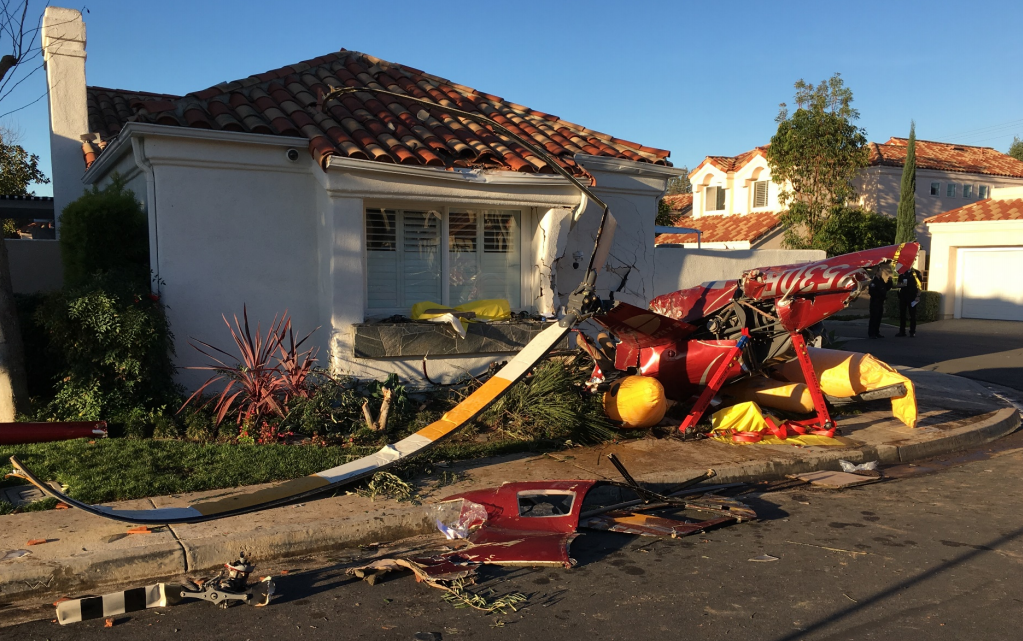Fatal R44 Loss of Control Accident: “Overweight and Out of Balance” Say NTSB (N7530R, Newport Beach, CA)
On 30 January 2018 a privately operated Robinson R44, N7530R, was destroyed on impact houses near Newport Beach, California about a minute after takeoff from John Wayne-Orange County Airport (SNA), Santa Ana, California. The private pilot and two passengers were fatal injured, one passenger sustained serious injuries and one person on the ground received minor injuries.
The Accident Flight
According to the US National Transportation Board (NTSB) safety investigation report (issued 8 April 2020):
The surviving passenger reported that the pilot and all of the passengers met at the pilot’s office and planned to fly to Catalina Island for lunch. Following a brief conversation, the pilot drove the passengers to the airport. The passenger stated that, during the drive, the pilot received a phone call during which he appeared to be frustrated. The passenger asked if everything was ok, and the pilot responded everything was fine and he just wanted a different helicopter.
NTSB don’t elaborate on what that might have meant and whether that frustration could have been a distraction. They don’t seem to have interviewed whoever the call was with either, which is surprising.
Upon arriving at the airport, they all walked to the helicopter and the pilot appeared to conduct a preflight inspection. The passenger recalled that the pilot never asked any of the passengers about their weights, nor did he assign them seats.
The pilot had flown only 195 hours in total.
Surveillance video footage of the takeoff showed the helicopter slightly move forward in a nose low attitude, lift off, rotate left, increase in a nose-low attitude, and yaw to the right. As the helicopter briefly transitioned into a level attitude, it moved momentarily out of view behind a parked airplane. The tailboom of the helicopter became visible shortly after, in an elevated attitude consistent with a nose-low pitch attitude. As the rest of the helicopter became visible, it appeared to be in a slight climbing left turn, remaining in a nose-low attitude. The helicopter briefly descended and appeared to transition into a level attitude before it began a climb. The helicopter continued the climb while transitioning to a nose-low pitch attitude as it traveled out of frame. A…witness reported that they observed the helicopter flying on an easterly heading and descending until it impacted two residential houses. A review of archived Federal Aviation Administration (FAA) radar data…showed that the helicopter climbed to a maximum altitude of 500 ft mean sea level (msl) and traveled along a southeasterly heading for about 13 seconds. The data showed that the helicopter then descended from 500 ft msl to the last recorded target, at 200 ft msl, in 11 seconds…almost directly above the initial impact area. The helicopter impacted multiple residential structures and a residential street about 0.95 nm miles south-southeast of the departure end of runway 20R at SNA.
https://youtu.be/qHQ2pwTKw80 The surviving passenger, who was making their first helicopter flight, said:
I remember looking straight down between my legs through the glass at the ground rushing toward us and saying “God no! God no! No God! No God!” and instinctively preparing for impact. It is so complicated to explain the feeling at impact because it was so hard, loud and really indescribable if you haven’t been through this. Everything was white for a split second as my mind and body tried to comprehend what happened and that I was still alive. Then I remember the intense pain, the taste of blood, the broken glass and crumpled metal around me as I was basically halfway in and out of the helicopter, almost on the ground.
The NTSB note that:
Following transport to the hospital, the [surviving] passenger reported to law enforcement that the pilot said “something’s wrong” and apologized to the passengers before stating that he could probably “save it.”
Safety Investigation
No mechanical defect was found with the aircraft. Weight and balance calculations were completed by Robinson and are in their report (50Mb) in the public docket. 
Using the basic empty weight of the helicopter, fuel load, and weights of the occupants and baggage, the helicopter weighed about 2,476 lbs at the time of takeoff with a longitudinal center of gravity (CG) of 93.42 inches.
The calculated weight exceeded the published maximum gross weight of 2,400 lbs [We note: by only 3%] and the CG was near the forward range noted in the R44 Pilot Operating Handbook [We note: ‘near’ and would only go out of range after further fuel burn].
Its unfortunate that there was no onboard recorded data available and limited ground video, the witnesses were not interviewed with technology such as the innovative Immersive Witness Interview application from IWI and the survivor was on their first ever helicopter flight.
NTSB Probable Cause
The pilot’s failure to perform weight and balance calculations before departing on the flight, which resulted in his operation of the helicopter outside of its published weight and balance limitations and a subsequent loss of control shortly after takeoff.
Safety Resources
Robinson Safety Notice SN-44 discusses carrying passengers and the responsibilities of a pilot. Other Aerossurance loading articles include:
- An AW109SP, Overweight VIPs and Crew Stress A heavy landing after a crew were put under considerable stress during a poorly planned VIP flight booking and a hurried overweight take off in the UAE.
- Wait to Weight & Balance – Lessons from a Loss of Control
- Deadly Combination of Misloading and a Somatogravic Illusion: Alaskan Otter
- Misloading Caused Fatal 2013 DHC-3 Accident
- Inadequately Secured Cargo Caused B747F Crash at Bagram, Afghanistan
- Inadequately Secured Pallets Penetrate the Rear Pressure Bulkhead of a Cargo B737
- Culture + Non Compliance + Mechanical Failures = DC3 Accident
- The Passengers Who Caused a 737 Tail Strike: Ground Handling Lessons
- Low Viz Helicopter Accident, Alaska, also with a loading aspect.
- Alaskan AS350 CFIT With Unrestrained Cargo in Cabin
- Time Pressures and Take-Off Trim Trouble
- Fatal Wisconsin Wire Strike When Robinson R44 Repositions to Refuel
- EC120 Forgotten Walkaround
- Flawed Post-Flight and Pre-Flight Inspections Miss Propeller Damage
- Too Rushed to Check: Misrigged Flying Controls
- When Habits Kill – Canadian MD500 Accident
- Troublesome Tiedowns
- Troublesome Tiedowns: The Sequel
- RCMP AS350B3 Left Uncovered During Snowfall Fatally Loses Power on Take Off
- EC130B4 Destroyed After Ice Ingestion – Engine Intake Left Uncovered
- Austrian Police EC135P2+ Impacted Glassy Lake (an example of IWI use)
- Stabilised Hover Prevents Loss of Control Accidents Say FAA
- UPDATE 9 October: 2020: Latent Engine Defect Downs R44: NR Dropped to Zero During Autorotation
- UPDATE 5 February 2021: Inexperienced IIMC over Chesapeake Bay (Guimbal Cabri G2 N572MD): Reduced Visual References Require Vigilance
- UPDATE 23 October 2021: A Lethal Cocktail: Low Time, Hypoxia, Amphetamine and IMC
- UPDATE 9 July 2022: R44 Ditched After Loss of TGB & TR: Improper Maintenance


Recent Comments